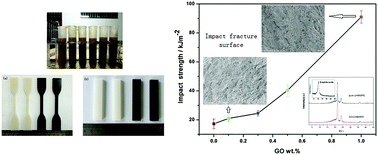Mechanical and thermal properties of graphene oxide/ultrahigh molecular weight polyethylene nanocomposites
Abstract
Graphene oxide (GO) was prepared according to a modified Hummers method, and a range of GO/ultrahigh molecular weight polyethylene (UHMWPE) composites were fabricated using liquid-phase ultrasonication mixing followed by hot-pressing. The thermal performances of the GO/UHMWPE composites were characterized by TGA and DSC. The dispersion of GO in GO/UHMWPE composites was investigated by FTIR and XRD. Moreover, the mechanical properties, including micro-hardness, tensile properties, and impact strength of GO/UHMWPE composites were also studied and the fractured surfaces were observed under SEM. The results show that the melting temperature of these composites was about 135 °C and the crystallinity was improved with the addition of GO. Moreover, the initial decomposition temperature was about 472 °C and the addition of GO improved the thermal performance of GO/UHMWPE. Furthermore, not only was the impact strength increased substantially with the addition of GO, but the micro-hardness was also improved gradually and the tensile properties were improved with the addition of GO. The thermal and mechanical performances of the GO/UHMWPE composites are influenced by the free-space effect and interaction-force effect.


 Please wait while we load your content...
Please wait while we load your content...